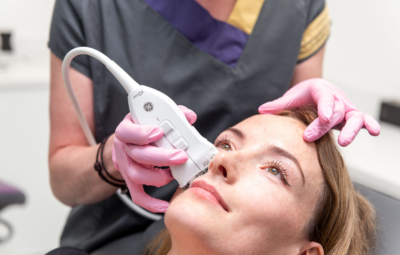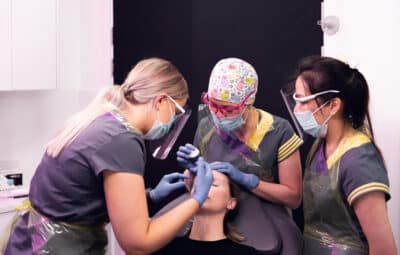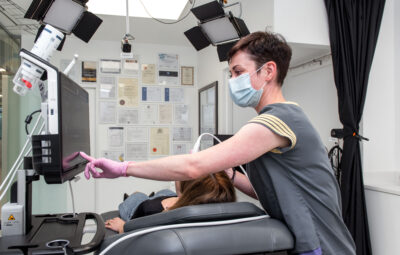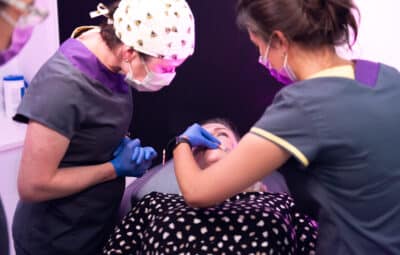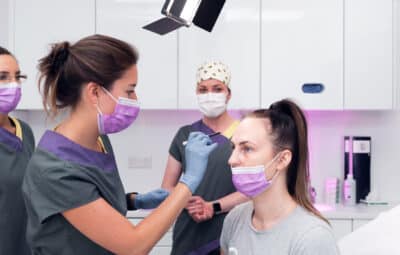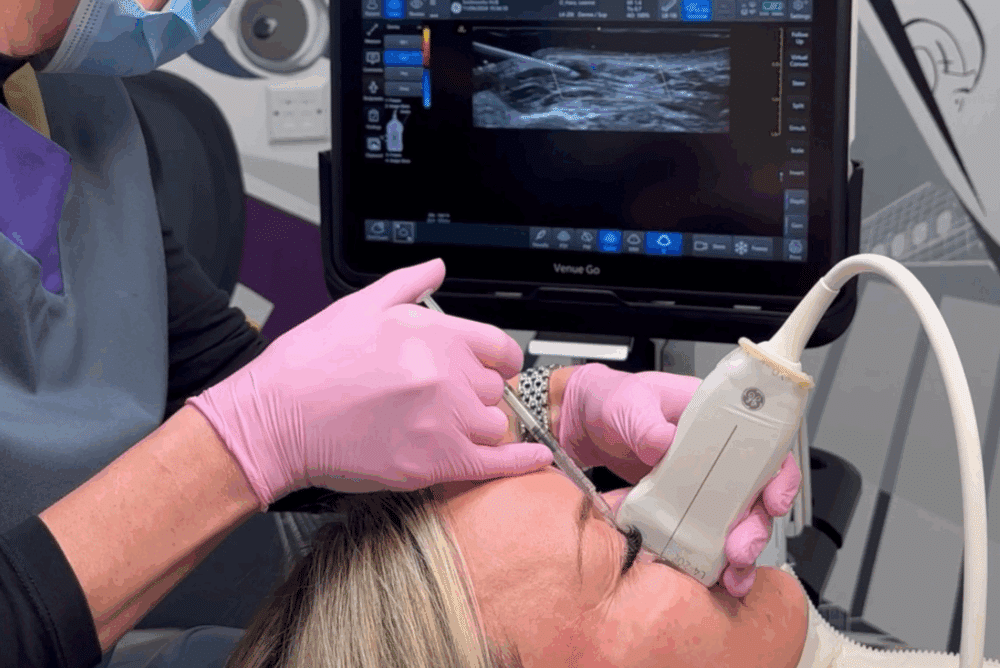
When Does Blindness Occur After Fillers? A Deep Dive into Risks
20 February 2025
In this post:
- Filler blindness is a rare but serious complication caused by injected material entering an artery, leading to sudden and often irreversible vision loss. High-risk areas include the nose, forehead, and glabella.
- Safe injecting techniques, slow and controlled injections, using cannulas, and having in-depth knowledge of facial anatomy help reduce risks.
- Facial ultrasound enhances patient safety by allowing real-time visualization of vascular structures, preventing accidental arterial injections.
- Immediate action, including stopping injections, using hyaluronidase, and referring patients to specialists, is critical within the 60-90 minute window.
This year we’ve seen dermal filler treatments only continue to surge in popularity. These injectables offer non-surgical facial enhancements with minimal downtime, something that is highly appealing to many patients. While these procedures are largely considered safe when performed by trained professionals, serious complications can still occur. One of the most devastating is blindness.
Unfortunately, there are too many injectors who simply don’t have the experience to treat safely in these advanced areas. This is especially prevalent in the UK where there is a notorious lack of aesthetic regulation. Not enough training combined with a non-medical background can lead to horrific complications. As medical injectors, it’s up to you to prevent these complications from happening.
In this blog post, we’ll explore when and why blindness occurs after filler injections, the highest-risk areas, prevention strategies, and how facial ultrasound is revolutionising patient safety. We’ll also cover what you should do in the event of a filler blindness emergency, with a short video full of tips from Smileworks Aesthetic Training HUB founder Dr MJ Rowland-Warmann.
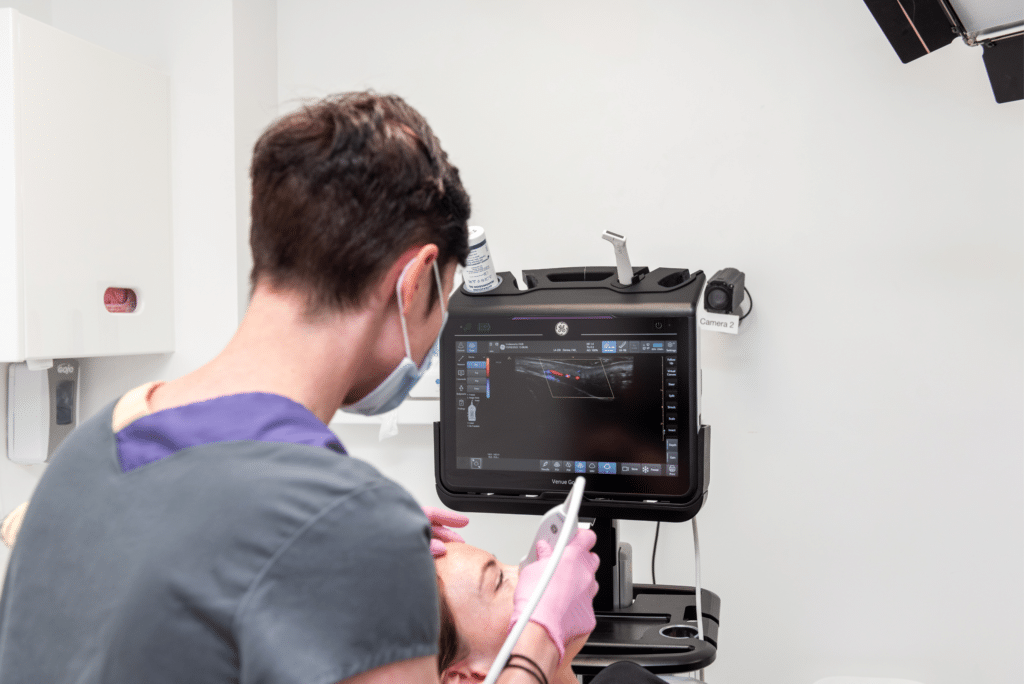
“I Went Blind From Fillers”
This is a statement no injector wants to hear from their patient. When a patient says this, it’s crucial to understand what exactly they mean. Though rare, filler blindness refers to a serious and often irreversible complication when injected material enters a blood vessel and travels to the ophthalmic artery, cutting off blood supply to the retina. This results in a sudden and complete loss of vision in the affected eye.
This is called a central retinal artery occlusion (CRAO), and it’s among the worst vascular occlusions a patient can experience. CRAO leads to rapid ischemia and can cause irreversible vision loss within 60-90 minutes. There is a small window of time after this occlusion occurs before vision loss becomes permanent.
Despite the medical severity of CRAO, the chances of it happening are still incredibly low. Most injections, when performed properly, do not lead to such horrific outcomes. According to the Aesthetic Surgery Journal, there have been 365 reported cases of filler blindness between 2018 and 2023. This works out to be about 60 cases a year.
When Does Filler Blindness Occur?
Filler blindness typically occurs when filler material is inadvertently injected into an artery. Certain factors increase the likelihood of this event, such as the location of the injection and technique areas. High-risk areas include:
- Nasal Region – 40.6% of cases
- Forehead – 27.7% of cases
- Glabella – 19% of cases
These regions are in close proximity to major arteries that supply blood to the eyes and brain. Injecting into these areas puts pressure on the blood vessels. If the needle or cannula inadvertently punctures an artery, the filler could flow into the ophthalmic artery and cut off blood supply.
The depth of injection is also a critical factor. Injections that are too deep may reach and damage these arteries, whereas superficial injections are less likely to cause harm. Injecting with excessive pressure can also force filler material into these unintended areas.
However, one of the most significant causes of filler blindness is the injector lacking knowledge of vascular anatomy. Understanding where the arteries are located and how to avoid them is essential. At Smileworks Liverpool, our injectors utilise facial ultrasound during treatment to visualise facial vessels in real time. This adds an extra layer of safety for our patients.
How to Prevent Blindness During Filler Injections
High Quality Training
Filler blindness prevention starts with knowledge. Injectors must be well-versed in facial anatomy, particularly the major arteries near the eyes, nose, and forehead. This includes understanding the deep and superficial vascular networks to ensure that each treatment is performed safely.
Theoretical training is essential. This is where injectors will learn facial anatomy for aesthetics. Too many aesthetic courses are hands-on only and do not give their delegates the necessary anatomy knowledge they need. Continuing education is also vital for injectors to stay up-to-date on the latest safety protocols and techniques.
Slow and Controlled Injections
When injecting dermal filler, take care to inject slowly and incrementally to avoid applying excessive pressure to the tissue. Injecting in small amounts reduces the chances of pushing filler into an unintended vessel.
On top of this, you should also make sure the filler is injected at the appropriate depth. Subdermal injections are safer than deeper ones that can reach vessels. As you inject more and gain experience, you’ll eventually feel more confident to inject deeper and perform advanced filler treatments.
Use a Cannula
Using a cannula rather than a needle can reduce the risk of hitting an artery. A cannula is a blunt instrument that glides more smoothly through the skin, reducing the likelihood of puncturing blood vessels. But even with this added safety, cannula use should still be coupled with precise anatomical knowledge and caution.
Facial Ultrasound
One of the most significant advancements in the past decade for preventing blindness is the use of facial ultrasound during treatment. Ultrasound technology allows practitioners to visualise the underlying blood vessels in real-time. This helps you avoid accidental injection into arteries.
By integrating ultrasound into aesthetic treatments, injectors can work with more confidence and accuracy. Here at the HUB, we offer an array of beginner facial ultrasound and advanced facial ultrasound courses. Under Dr MJ’s expert teachings, you’ll leave these courses prepared to implement facial ultrasound in your practice and improve safety for your patients.
Signs of Filler Blindness: What to Watch For
It’s important for both the injector and the patient to be aware of the early warning signs that something has gone wrong. The most immediate indication of a vascular occlusion leading to filler blindness is pain, particularly if it occurs suddenly and intensely during or shortly after the injection.
Patients may also experience vision changes in the affected eye, such as blurriness, dimming of vision, or complete loss of sight. None of these symptoms are normal side effects of dermal filler injections, and you should tell your patient to let you know right away if they experience any of these.
In addition to eye-related symptoms, changes in skin colour (such as a white, grey, or blue appearance) can indicate that the blood supply to that area has been compromised. Again, it’s critical for patients to communicate any unusual sensations or vision changes to the injector immediately.
If these signs appear, the injector should stop the procedure immediately and proceed with their complication management plan. Quick action can make all the difference in the outcome.
What to Do If Blindness Occurs
The above video is a short clip from our online Advanced Facial Ultrasound course. Dr MJ outlines what to do in the event of a visual disturbance. For the full video and course, the advanced course is available to enrol in today!
If filler blindness occurs, time is of the essence. The first step is to immediately cease the injection, note the time of the event, and call for help. Chances are that eyes are not in your scope of practice, so it’s crucial to get your patient in the hands of an expert as soon as possible.
In the meantime, there are few steps you can take to lessen the symptoms. Use hyaluronidase along the injection site to break down the filler. This can sometimes help reverse the blockage if administered promptly.
The patient should lay in a supine position to encourage blood flow to the area, and the injector should place timolol eye drops to reduce intraocular pressure. This is critical to prevent further damage to the retina. Aspirin and prednisolone can also be administered during this time.
By this point, the patient should have been transferred or on their way to being transferred to a specialist who can offer more advanced treatments like thrombolysis. The goal is to get the patient seen by A&E or ophthalmologist within 60-90 minutes.

Learn Facial Ultrasound from Expert Dr MJ
While the risk of filler blindness is rare, it is a serious complication that injectors must understand and be prepared for. Even the most experienced injectors can find themselves in this situation. As we’ve mentioned, prevention is key, and tools like facial ultrasound can significantly reduce the risks of filler blindness.
There is no single more important tool to have in your practice than facial ultrasound. It is among the only ways to ensure safety for your patients.
If you’re interested in learning the art of facial ultrasound, look no further than the Smileworks Aesthetic Training HUB – an esteemed aesthetic training centre based in the UK. We pride ourselves on our wide range of online and hands-on courses tailored for every skill level.
You can start with our beginner facial ultrasound course to learn the basics of how to use this revolutionary technology in your practice. We also have an Advanced Facial Ultrasound course that dives deep into how to recognise different types of filler, treat with ultrasound guided injections, and manage complications.
We also have 1-2-1 mentoring sessions available for those looking for more personalised training. Regardless of your skill level, we have something for everyone at the HUB!
It’s time to embrace the prospering world of aesthetic medicine. The HUB provides you with all the right training and guidance you need to succeed. Take control of your professional journey and step into a future filled with endless potential and opportunities.
Join us at the HUB. Let’s shape the future of aesthetic medicine together and ensure safe, effective, and transformative results for every patient.
Want to try out our courses before committing? Take advantage of our free trial for a taste of what learning at the HUB is like.
Related blog posts:
